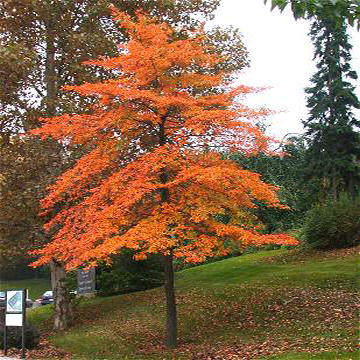

Nyssa sylvatica - (image 1 of 7)
Taxonomy
Family: Nyssaceae
Habitat
Boggy or peaty soils. Wet wooded flats. Usually in acid soil but somewhat adaptable in cultivation.
Associates
Distribution
Southern ME south to FL, west to southeast WI, east and southern IL, MO, and TX.
Morphology
Deciduous tree to 30 m with a horizontal branching pattern; Leaves often crowded on short shoots, elliptic to obovate, to 15 cm long, abruptly short acuminate, typically entire or with a few coarse teeth. Staminate flowers on pedicels 1-5 mm, in umbels or umbellate racemes on peduncles 1-3 cm; pistillate flowers 2-4, on peduncles up to 6 cm long, with 5 small sepals. Fruit blue-black, glaucous, ovoid or globular, 1-1.5 cm; stone with about 10 shallow grooves.
Notes
Flowers early May to mid July.
Wetland indicator: Facultative
A highly ornamental tree but not very adaptable to urban conditions. Also called Black Gum. Typically dioecious, with male and female flowers on separate trees. The second image shows male (staminate) flowers, while the third image shows female (pistillate) flowers.
References
Gleason, Henry A. and A. Cronquist. 1991. Manual of Vascular Plants of
Northeastern United States and Adjacent Canada. Second Ed.
The New York Botanical Garden. Bronx, NY
Swink, F. and G. Wilhelm. 1994. Plants of the Chicago Region.
Indiana Academy of Science. The Morton Arboretum. Lisle, Illinois.
|
Michael Hough © 2005 |